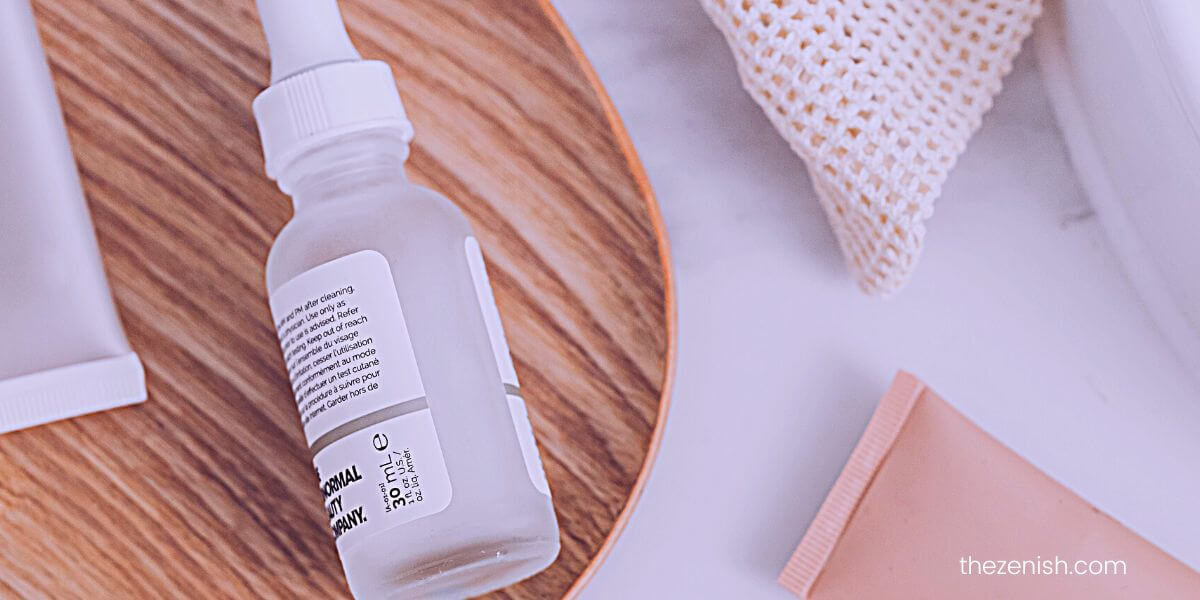Tired of dealing with acne, dark spots, and other skin imperfections?
Trust me, you’re not alone.
Finding the right skincare products to address these issues can be daunting. But, two ingredients have been making waves in skincare: azelaic acid and niacinamide.
Both ingredients have been praised for their ability to improve the appearance of the skin, but what’s the difference between the two?
When comparing azelaic acid vs niacinamide, which one is better? Which one should you use?

Let’s explore the differences between azelaic acid vs niacinamide, their benefits, and how to choose the best products for optimal results.
| this post may contain affiliate links, which means if you purchase from one of these links, I may receive a small commission at no additional cost to you. |
What is azelaic acid?
This skincare ingredient is a bit of a mouthful, but don’t let that scare you off.
Essentially, azelaic acid is a naturally occurring acid derived from grains like barley and wheat (a great option if you’re looking for a cruelty-free skincare solution).
Cool, right? But…
What does azelaic acid actually do for your skin?
Azelaic acid benefits
- Antibacterial properties
One of the main uses of azelaic acid is for treating the bacteria that cause acne. It is very effective in reducing the number of acne lesions on the skin.
It works by stopping the production of keratin, which is a fancy way of saying it unclogs your pores and prevents acne from forming in the first place.
- Reduces inflammation
And it doesn’t stop there – azelaic acid is also anti-inflammatory, which means it can help calm down any redness and swelling that comes along with acne or rosacea.
- Helps fade hyperpigmentation
But it also works wonders on hyperpigmentation and melasma, by putting the brakes on melanin production (the stuff that gives your skin its color), helping to fade dark spots and even out your skin tone.
See also: Melasma vs hyperpigmentation: what’s the difference?
- Improves skin texture
And the benefits don’t stop there – azelaic acid is also a great exfoliator (gently exfoliating your skin and promoting cell turnover), helping to unclog pores and leaving your skin looking smoother and brighter.
Azelaic acid side effects
Of course, like any skincare ingredient, there are some potential side effects to be aware of.
- You may experience dryness or peeling, especially when you first start using azelaic acid.
- If you have sensitive skin, you may want to start with a lower concentration to avoid any irritation.
But overall, the benefits of azelaic acid definitely outweigh the risks.
So if you’re looking to tackle acne, hyperpigmentation, or inflammation, this might just be the ingredient for you!
What is niacinamide?
Niacinamide is a form of vitamin B3 that has some pretty awesome benefits for your skin.
You can find this water-soluble vitamin in foods like meat, fish, and dairy, or as a supplement, but it’s also a popular ingredient in skincare products.
So what exactly does it do?
Niacinamide benefits
Using niacinamide can do wonders for your skin! It’s known to improve skin hydration (improving the skin barrier), reduce redness, and help with fine lines and wrinkles.
- Hydrates and moisturizes
If you have dry or dehydrated skin, Niacinamide can help improve your skin’s barrier function, thus preventing moisture loss and keeping it hydrated.
Furthermore, it helps increase the production of natural moisturizing factors, such as hyaluronic acid, which can help plump up your skin and reduce the appearance of fine lines and wrinkles.
See also: What does niacinamide do for your skin?
It’s also effective in reducing the appearance of age spots and hyperpigmentation.
- Reduces hyperpigmentation
Niacinamide has been shown to help reduce the appearance of hyperpigmentation by inhibiting the transfer of melanin to the skin’s surface, which can help fade age spots, dark spots, and other types of hyperpigmentation.
See also: 23 Best facial cleansers for dark spots and hyperpigmentation
It can also help prevent hyperpigmentation by protecting the skin from UV damage.
- Helps acne – reduces fine lines and wrinkles
If you struggle with acne, you should definitely add niacinamide to your skincare arsenal.
It helps regulate sebum production, leading to fewer breakouts and has anti-inflammatory properties that can reduce inflammation caused by acne.
And the best part?
It’s super versatile and can be used by pretty much anyone. It’s gentle enough for sensitive skin, but also effective enough if you’re dealing with more severe issues like acne or rosacea.
Plus, it’s a great anti-aging ingredient, helping to reduce the appearance of fine lines and wrinkles.
Niacinamide side effects
Of course, there are some side effects to be aware of.
- You may experience redness or irritation when you first start using niacinamide, but this usually goes away after a few uses.
- And while it’s generally safe to use, it’s always a good idea to patch test first and start with a lower concentration if you have sensitive skin.
Azelaic acid vs niacinamide: how are they different?
Now that we’ve covered azelaic acid and niacinamide individually, let’s talk about how they stack up against each other.
While both ingredients are known for their skin-boosting benefits, they actually work quite differently!
Let’s take a closer look at azelaic acid vs niacinamide and see how they compare.
Similarities
What are the similarities between the two?
While they work differently, both ingredients are great for improving the overall health and appearance of your skin.
They can both reduce hyperpigmentation and inflammation, and they’re safe for most skin types.
Plus, they’re both pretty gentle, making them great options for daily use.
How are they different?
Azelaic acid is more geared toward tackling acne, inflammation, and hyperpigmentation. It works by exfoliating the skin and reducing the production of keratin (a protein that can clog pores).
On the other hand, niacinamide focuses on strengthening the skin barrier and improving hydration. It also has anti-inflammatory properties, but its main benefits are reducing redness, hyperpigmentation, and fine lines.
Azelaic acid vs niacinamide: Which is better for acne?
While both ingredients can help with acne, azelaic acid is generally considered more effective at reducing breakouts.
Its exfoliating properties help to unclog pores and reduce the production of keratin (which can contribute to acne).
Niacinamide can also be helpful for acne-prone skin, but it’s more focused on reducing inflammation and redness.
Azelaic acid vs niacinamide: Which is better for pigmentation?
If you’re dealing with dark spots or uneven skin tone, again both can be helpful.
Azelaic acid reduces the production of melanin, which can help to lighten dark spots and even out your skin tone.
Niacinamide can also help to reduce the appearance of dark spots and even out your skin tone, but it works in a different way.
It helps to inhibit the transfer of melanin to your skin cells, which can also help to reduce pigmentation.
Azelaic acid vs niacinamide: Which one is better for sensitive skin?
Both azelaic acid and niacinamide are generally well-tolerated by most skin types, including sensitive skin.
However, as with any skincare ingredient, there’s always the possibility of irritation or allergic reaction.
If you have very sensitive skin, it’s a good idea to start with a lower concentration and patch test first.
Can I use azelaic acid with niacinamide?
Absolutely! In fact, using both ingredients together can be a great way to tackle multiple skin concerns at once.
Just be sure to start with a lower concentration of each and patch test first to avoid any potential irritation.
When should you use these ingredients?
Azelaic acid is best used in the evening, as it can increase sensitivity to sunlight. Niacinamide, however, can be used both morning and night.
As always, be sure to follow up with a good SPF in the morning to protect your skin from UV damage.
Product recommendations
The Ordinary Niacinamide 10% + Zinc 1%
This affordable serum from The Ordinary is a cult favorite. It contains a fairly high concentration of niacinamide, which helps to regulate oil production and reduce the appearance of pores.
The addition of zinc helps to soothe inflammation and promote healing. It’s a great option if you have oily or acne-prone skin.
Paula’s Choice 10% Azelaic Acid Booster
This lightweight serum from Paula’s Choice contains a potent dose of azelaic acid, which helps to reduce redness and even out skin tone.
It also has antioxidant properties, which help to protect your skin from environmental stressors. It’s a good choice if you have sensitive skin, as it is fragrance-free and non-irritating.
SkinCeuticals Discoloration Defense
This serum from SkinCeuticals contains a combination of niacinamide, kojic acid, and tranexamic acid, all of which work together to reduce the appearance of dark spots and hyperpigmentation.
Try this if you have melasma or sun damage.
The Inkey List Niacinamide Oil Control Serum
This affordable serum from The Inkey List contains niacinamide, as well as other ingredients like squalane and hyaluronic acid, which help to hydrate and plump the skin.
It’s a great option if your skin is dry or dehydrated and you also struggle with excess oil.
Sunday Riley Good Genes All-In-One Lactic Acid Treatment
While not specifically a niacinamide or azelaic acid product, this cult-favorite treatment from Sunday Riley contains both ingredients, along with lactic acid and licorice root extract.
It helps to brighten and smooth the skin, while also reducing the appearance of fine lines and wrinkles.
It’s a splurge, but many swear by its transformative effects.
Overall, these five products are all great options for incorporating niacinamide and/or azelaic acid into your skincare routine.
Depending on your specific skin concerns and budget, any one of them could be a good fit for you.
So which one should you use?
Well, it really depends on your skin concerns. If you’re dealing with acne or inflammation, azelaic acid might be your best bet.
It’s also great if you have oily or combination skin since it helps to control oil production.
However, if you’re looking to improve hydration and reduce redness, then niacinamide is the way to go. It’s also a good choice if you have dry or sensitive skin.
Of course, you can always use both ingredients if you feel like they address different concerns for your skin.
Just be sure to introduce them slowly and do a patch test first, as some people experience irritation when using both products together.



